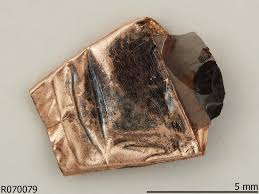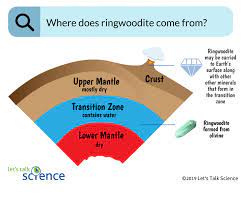Scientists have discovered a new ocean under Earth about 400 miles under the Earth’s surface in a rock called ‘ringwoodite.’ This discovery amidst the many scientific discoveries such as the new dream machine that can allow dreams to play out like movies, the missing continent that has been rediscovered after disappearing for 375 years, and a gaping hole in the sun has blown all our minds, and quite frankly seem a bit confusing at first glance, but let me break it down.
What is Ringwoodite?
Ringwoodite is unique because it is a sponge-like rock-seeming material that is a fourth state of matter. Ringwoodite is not a liquid, gas, or solid but a material that can store water. Ringwoodite was discovered in 1969 and was found in the Tenham meteorite and is thought to make up a good portion of the Earth’s mantle. The Earth’s mantle is a rock layer between the Earth’s crust and core. It tends to be hot and is the material most meteorites use.
Many scientific experiments have been held to discover how and what the Earth’s mantle contains, with some experiments “zapping olivine with lasers, shooting minerals with massive guns and squeezing rocks between diamond anvils to mimic the Earth’s interior.” according to Scientific American. These experiments concluded that the mantle of the Earth morphs to fit its surroundings depending on the depth at which it is found.
A diamond from a volcano in Brazil confirmed some of the experiments and models of the Earth’s mantle. It revealed that the olivine becomes ringwoodite at the depth of the transition zone in the Earth’s mantle. Ringwoodite has been found to contain about 1.5% water, but not as a liquid but rather as a hydroxide ion (just the oxygen and hydrogen molecules bonded together. This has led scientists to believe a mini ocean could be under the mantle’s transition zone, stretching about 254-410 miles deep.
Even though the mantle seems to contain a lot of ringwoodites, there may be places that have more water than others in different areas of the transition zomes, as volcanic eruptions underwater and the Earth’s tectonic plates and such could impact the amount of ringwoodite and the concentration of water in areas.
Why is this important?
Well, according to Hakai magazine, the ringwoodite in the Earth will ensure that we will always have an ocean. The ocean will never be empty because the ringwoodite contains an ocean. After all, it has molecular components and isn’t a liquid. When ringwoodite seeps into the ocean, it becomes watery and melting, which researchers call mantle rain.
A study conducted by Andrault and Bolfan-Casanova indicates that mantle rain could be the key to keeping the deep water cycle continuing, which means that the ocean will never get vaporized from the heat of the Earth’s core. In simple terms, this hidden ocean is important because it will maintain our ocean on the upper crust and allow for the continuation of life in the oceans.
















Margaret Wilson • Feb 25, 2024 at 9:11 am
Interesting- thanks for your article and research.